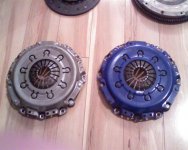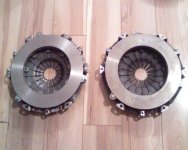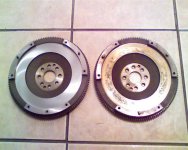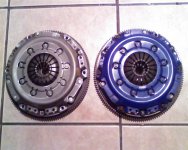Blank Redge
New CEG'er
- Joined
- Jun 7, 2010
- Messages
- 18
Maybe you guys already know this. I searched around and found plenty of complaints about the whine and chatter that the Spec Stage 1 clutch produces but I haven’t found any explanations as to why this happens. Adding to the confusion there seems to be a respectable sample size of people that report that they had no problems with their stage 1 disks after years and 30k+ miles of driving. Well when I bought my SVT back in May last year it came with a stage 1 that was just starting to whine after about 5k miles put on by the PO. I’ve put about 3k miles on it since then and I’m really tired of the whining so now I’m changing the clutch out for a standard LUK clutch. When I tore the whole thing apart and got the clutch disk out, it was apparent to me why it whined and chattered (please see attached pics).
What I have shown is a Spec Stage 1 clutch disk with the contact side of a Spec pressure plate (blue powder coat paint on the front side) that is part of the kit that the PO had put in, along side the standard Ford SVT flywheel. The other pictures show the uneven wear on the contact surfaces of the Spec clutch disk and a side-by-side comparison with a new OEM SVT Luk clutch.
For some of you this might seem familiar and fairly slight but there is actually a significant problem here. For starters the stage 1 clutch has a surface area that is way too big relative to the standard Ford SVT flywheel and even the Spec provided PP. Every other problem related this follows but I’ll explain more about that later. This is an obvious misapplication and I’m not sure how this happened. Did Spec put the wrong clutch disc in their Contour kits? I took some measurements of the widths of the contact surfaces using a digital slide caliper (Starrett 723). Here are results I obtained:
Width of the friction material of the Spec clutch: 1.75 inches
Width of the friction material of the Luk clutch: 1.36 inches
Width of the SVT flywheel contact surface: 1.49 inches
Width of the Spec branded pressure plate contact surface: 1.60 inches
Width of the Luk branded pressure plate contact surface: 1.60 inches
Thickness of Spec clutch friction material, pad-to-backing, worn surface: 0.125 inches
Thickness of Spec clutch friction material, pad-to-backing, unworn surface: 0.133 inches
Overall thickness of Spec clutch, pad-to-pad, worn surface, no marcel pressure: 0.306 inches
Overall thickness of Spec clutch, pad-to-pad, unworn surface, no marcel pressure: 0.334 inches
Spec rivet to pad surface distance (worn, PP side): 0.049 ~ 0.057 inches
Spec rivet to pad surface distance (worn, FW side): 0.053 ~ 0.063 inches
Thickness of Luk clutch friction material, pad-to-backing: 0.130 inches
Overall thickness of Luk clutch, pad-to-pad, no marcel pressure: 0.310 inches
Luk rivet to pad surface distance (new): 0.060 inches (consistent)
The fundamental principles in materials science are consistent in stating that whenever an application calls for an expendable friction material to be used with a durable iron material surface, the surface of the friction material shall not exceed the operational boundaries of the durable iron material surface. The reason for this is not purely economical in the sense that material could be wasted when it is not used but mechanical because as the friction material wears, sooner or later, the unworn excess material will intrude into areas that it was never designed to go. The academic question from analysis point-of-view usually follows: what happens next? The answers usually observed is: nothing good. In short, violation of this rule causes negative interaction in the boundary areas between the worn and unworn friction surfaces as it engages and disengages with the durable material. Specifically excessive vibrations due to a combination of forced and free oscillations from the aforementioned interaction typically causes all sorts of premature wear on the friction material, material carrier, and application system. This is why we don’t see brake pads larger than the rotors they arrest or clutch disks larger than the flywheels and pressure plates they have to work with (oh wait, opps).
So the whining and chattering were the symptoms of the vibrations, I have no doubt. Left unchecked, the oscillations can get so bad that they work the marcels like bending a paper clip back and forth. Sooner or later the marcel may crack. Uneven wear on the material caused by vibrations only makes the problem progressively worst as spikes of torque force may only be applied to a narrow concentrated arc of the disk versus to entire disk as an even whole. This could pop rivets and springs in the torsen carrier assembly. Finally, perhaps, the vibrations transmitted from the splined hub to the input shaft could cause accelerated wear on the bearings and seals of the transmission. The TOB could also be affected by vibrations transmitted by the PP. I have no idea what could be happening crank side, hopefully the flywheel has enough dampening power to overcome the effects, then again maybe not, it all depends and not the least factors like mode and frequency.
In closing, the Spec Stage 1 clutch disk itself seems fairly robust and well built. I have no qualms about its material and workmanship. 8k miles or so hasn’t been too bad on this thing. But then again I really babied this thing (because I didn’t like hearing the whine) and the PO wasn’t hard on it either. Regardless I just don’t know what application this clutch was originally designed for. It certainly wasn’t for the Contour or at least not with the stock flywheel or pressure plate. Perhaps there are aftermarket flywheels for the Contour that have contact widths greater than 1.75 inches. Does anyone know what a Fidanza width is? What really troubles me is that the Spec provided pressure plate is also too small for clutch disk. Now what is up with that? I think we all might be hard pressed to find a pressure plate with a contact side that wide for our ‘tours. Does anyone know differently? The important lesson to walk away from this may very well be: if you’re going to replace your clutch, make sure it “fits” your flywheel and pressure plate setup.
Just thought you should all know...Comments, suggestions, advice anyone?
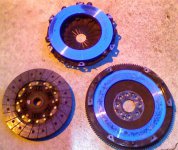
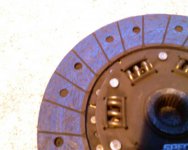
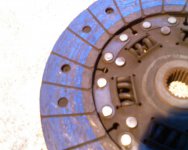
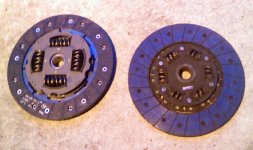
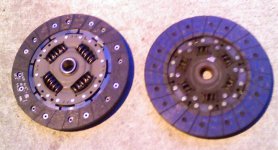
What I have shown is a Spec Stage 1 clutch disk with the contact side of a Spec pressure plate (blue powder coat paint on the front side) that is part of the kit that the PO had put in, along side the standard Ford SVT flywheel. The other pictures show the uneven wear on the contact surfaces of the Spec clutch disk and a side-by-side comparison with a new OEM SVT Luk clutch.
For some of you this might seem familiar and fairly slight but there is actually a significant problem here. For starters the stage 1 clutch has a surface area that is way too big relative to the standard Ford SVT flywheel and even the Spec provided PP. Every other problem related this follows but I’ll explain more about that later. This is an obvious misapplication and I’m not sure how this happened. Did Spec put the wrong clutch disc in their Contour kits? I took some measurements of the widths of the contact surfaces using a digital slide caliper (Starrett 723). Here are results I obtained:
Width of the friction material of the Spec clutch: 1.75 inches
Width of the friction material of the Luk clutch: 1.36 inches
Width of the SVT flywheel contact surface: 1.49 inches
Width of the Spec branded pressure plate contact surface: 1.60 inches
Width of the Luk branded pressure plate contact surface: 1.60 inches
Thickness of Spec clutch friction material, pad-to-backing, worn surface: 0.125 inches
Thickness of Spec clutch friction material, pad-to-backing, unworn surface: 0.133 inches
Overall thickness of Spec clutch, pad-to-pad, worn surface, no marcel pressure: 0.306 inches
Overall thickness of Spec clutch, pad-to-pad, unworn surface, no marcel pressure: 0.334 inches
Spec rivet to pad surface distance (worn, PP side): 0.049 ~ 0.057 inches
Spec rivet to pad surface distance (worn, FW side): 0.053 ~ 0.063 inches
Thickness of Luk clutch friction material, pad-to-backing: 0.130 inches
Overall thickness of Luk clutch, pad-to-pad, no marcel pressure: 0.310 inches
Luk rivet to pad surface distance (new): 0.060 inches (consistent)
The fundamental principles in materials science are consistent in stating that whenever an application calls for an expendable friction material to be used with a durable iron material surface, the surface of the friction material shall not exceed the operational boundaries of the durable iron material surface. The reason for this is not purely economical in the sense that material could be wasted when it is not used but mechanical because as the friction material wears, sooner or later, the unworn excess material will intrude into areas that it was never designed to go. The academic question from analysis point-of-view usually follows: what happens next? The answers usually observed is: nothing good. In short, violation of this rule causes negative interaction in the boundary areas between the worn and unworn friction surfaces as it engages and disengages with the durable material. Specifically excessive vibrations due to a combination of forced and free oscillations from the aforementioned interaction typically causes all sorts of premature wear on the friction material, material carrier, and application system. This is why we don’t see brake pads larger than the rotors they arrest or clutch disks larger than the flywheels and pressure plates they have to work with (oh wait, opps).
So the whining and chattering were the symptoms of the vibrations, I have no doubt. Left unchecked, the oscillations can get so bad that they work the marcels like bending a paper clip back and forth. Sooner or later the marcel may crack. Uneven wear on the material caused by vibrations only makes the problem progressively worst as spikes of torque force may only be applied to a narrow concentrated arc of the disk versus to entire disk as an even whole. This could pop rivets and springs in the torsen carrier assembly. Finally, perhaps, the vibrations transmitted from the splined hub to the input shaft could cause accelerated wear on the bearings and seals of the transmission. The TOB could also be affected by vibrations transmitted by the PP. I have no idea what could be happening crank side, hopefully the flywheel has enough dampening power to overcome the effects, then again maybe not, it all depends and not the least factors like mode and frequency.
In closing, the Spec Stage 1 clutch disk itself seems fairly robust and well built. I have no qualms about its material and workmanship. 8k miles or so hasn’t been too bad on this thing. But then again I really babied this thing (because I didn’t like hearing the whine) and the PO wasn’t hard on it either. Regardless I just don’t know what application this clutch was originally designed for. It certainly wasn’t for the Contour or at least not with the stock flywheel or pressure plate. Perhaps there are aftermarket flywheels for the Contour that have contact widths greater than 1.75 inches. Does anyone know what a Fidanza width is? What really troubles me is that the Spec provided pressure plate is also too small for clutch disk. Now what is up with that? I think we all might be hard pressed to find a pressure plate with a contact side that wide for our ‘tours. Does anyone know differently? The important lesson to walk away from this may very well be: if you’re going to replace your clutch, make sure it “fits” your flywheel and pressure plate setup.
Just thought you should all know...Comments, suggestions, advice anyone?






